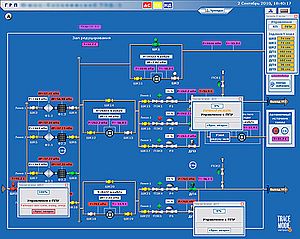Supervisory Control and Data Acquisition facts for kids
SCADA stands for Supervisory Control and Data Acquisition. It's a special computer system that helps people watch over and control big machines and processes, especially in factories or large systems like water pipes or power grids. Think of it like a giant brain that helps manage important operations from far away.
SCADA systems are used in many places. They can control things like how much water flows through pipes, how electricity gets to your home, or how products are made in a factory. They collect information (data) from different parts of a system and send it to a central computer. This allows people to see what's happening and make changes if needed, all from one place.
Contents
What is SCADA?
SCADA is a type of control system. It helps manage and automate many industrial jobs. Instead of people having to be everywhere at once, SCADA lets them supervise and control things remotely. This means they can be in an office and still know exactly what's happening on the factory floor or at a faraway water pump.
How Does SCADA Work?
SCADA systems use computers, special software, and communication tools. They gather data from sensors that measure things like temperature, pressure, or flow. This data is then sent to a central computer. Operators can see this information on screens, often as easy-to-understand pictures or diagrams.
If something needs to be changed, like turning a pump on or off, the operator can send a command from the computer. The SCADA system then sends this command to the right equipment. This makes managing complex systems much easier and safer.
Important Parts of SCADA
A SCADA system has a few key parts that work together:
- Sensors and Actuators: These are like the "eyes" and "hands" of the system. Sensors measure things (like how full a tank is). Actuators are devices that perform actions (like opening a valve).
- Remote Terminal Units (RTUs) or Programmable Logic Controllers (PLCs): These are small computers located near the equipment. They collect data from sensors and send commands to actuators. They also send information back to the main control center.
- Communication Network: This is how all the parts talk to each other. It can use wires, radio signals, or even the internet.
- Master Terminal Unit (MTU) or Human-Machine Interface (HMI): This is the main computer system where operators work. The HMI is the screen and software that shows all the information and lets operators send commands. It's like the dashboard of a very complex machine.
Where is SCADA Used?
SCADA systems are super important in many industries. They help make sure things run smoothly and safely.
Water and Wastewater
SCADA helps manage water treatment plants and distribution systems. It monitors water levels in reservoirs, controls pumps, and checks water quality. This ensures clean water gets to homes and businesses.
Electric Power
In power plants and electrical grids, SCADA monitors power generation and distribution. It helps manage the flow of electricity and quickly finds problems like power outages. This keeps the lights on for everyone.
Oil and Gas
SCADA is used to monitor pipelines, oil wells, and refineries. It helps control the flow of oil and gas, ensuring safe and efficient transport.
Manufacturing
In factories, SCADA systems control assembly lines and production processes. They monitor machine performance, manage inventory, and ensure products are made correctly and efficiently.
Why is SCADA Important?
SCADA systems are important for several reasons:
- Efficiency: They help industries run more smoothly and use resources better.
- Safety: By monitoring systems, SCADA can detect problems early, preventing accidents or equipment damage.
- Cost Savings: Automating tasks and optimizing processes can save a lot of money.
- Reliability: SCADA helps ensure that essential services, like water and electricity, are delivered without interruption.
In short, SCADA is a powerful tool that helps us manage the complex systems that are part of our daily lives, making them safer, more efficient, and more reliable.
Images for kids
See also
 In Spanish: SCADA para niños
In Spanish: SCADA para niños




